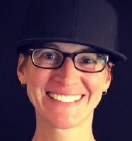Learning new technologies for a person with disabilities can be overwhelming for some and not so for others. Some people with disabilities benefit from one-on-one training on how to use various devices. The DeafBlind community has a variety of services available for them, including assistance from T-Mobile Accessibility’s DeafBlind Outreach (DBO) team! DBO can provide DeafBlind community members with one-on-one training where a T-Mobile Accessibility team member meets with them and together, they co-navigate their mobile phone, accessibility features available on their mobile devices, ensure they are connected to the braille devices, and learn how to use T-Mobile IP Relay to make phone calls!
Even better, there is amazing technology available that is designed for diverse people with disabilities—including devices that utilize assistive technology. Assistive Technology (AT) is defined as “special devices and software that people with disabilities can use to access the environment and gain information” (source: https://aphconnectcenter.org/). The goal of an AT device is to ensure individuals with disabilities have equal access to communications. Assistive Technology takes various forms; it can be a piece of equipment, or a product system that is used to increase, maintain, and/or improve the life experience of individuals with disabilities.
Assistive technology can be as simple as magnification or as complex as computer systems with built-in software that provides a person within the blind spectrum access to the digital world. One category of software includes screen readers and voice recognition tools. These can be simple or sophisticated, with some that will even sync with a braille device. The software can also be adapted for a person within the deafblind spectrum, enabling them to access the web and various applications. With this, users can be connected to and communicate with anyone, virtually anywhere and at any time.
Bet you didn’t think of this. The magnifier found on most smart phones is an example of a simple but extremely useful tool that is an AT tool for some users. For users who are blind or low vision, a tap on the phone screen will bring up the accessibility shortcut menu that presents the user with options. For example, if the person who is blind or has low-vision is in a café and finds the menu difficult to read in a low-light environment, that person can bring up the phone’s magnifier, take a picture of the menu, and then choose how they want to access the menu — enlarge the menu, invert the colors, add more lighting to make it more readable, etc. This Screen magnification feature makes reading much easier.
Others might benefit more by accessing this information through a braille device. This is possible now as more places offer menus via a QR code (Quick Response Code, which was invented by Denso Wave in 1994; source: https://www.microsoft.com/en-us/brief-history-qr-codes). A QR code allows individuals with disabilities to choose how they want to access the information through their devices, and individuals can adapt the device to meet their specific needs.
Even using the telephone calling feature offers accessibility options which allow people who are deaf to access captions on their devices. This is one of many applications available for the deaf community as well as for people who are DeafBlind or who have speech disabilities. These apps enable users to choose how they communicate with others — whether by speech-to-text or text-to-speech. These communities also have many other options for making and receiving calls, including FaceTime, text, or T-Mobile IP Relay. T-Mobile IP Relay enables people who are deaf, DeafBlind, hard of hearing, or who have a speech disability to make or receive a call via text on a mobile phone from virtually anywhere.
Want to learn more about T-Mobile Accessibility services? Check out our website at t-mobile.com/access.
References:
A Brief History of QR codes. Received from https://www.microsoft.com/en-us/microsoft-365-life-hacks/privacy-and-safety/brief-history-qr-codes#:~:text=In%201994%2C%20a%20Denso%20Wave,and%20white%20stones%20placed%20throughouton April 2, 2024.
Assistive Technology and the Expanded Core Curriculum What is Assistive Technology (AT)? Received from https://aphconnectcenter.org/familyconnect/education/ecc/assistive-technology/assistive-technology-and-the-expanded-core-curriculum/ on April 2, 2024.

